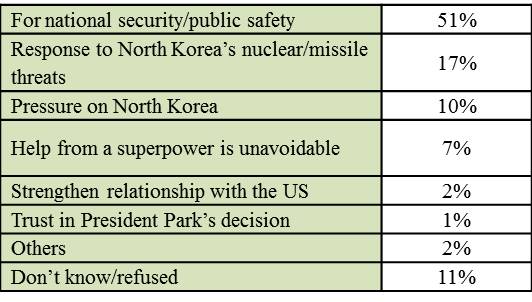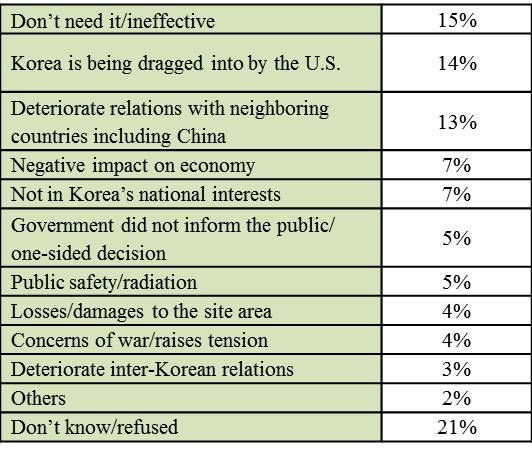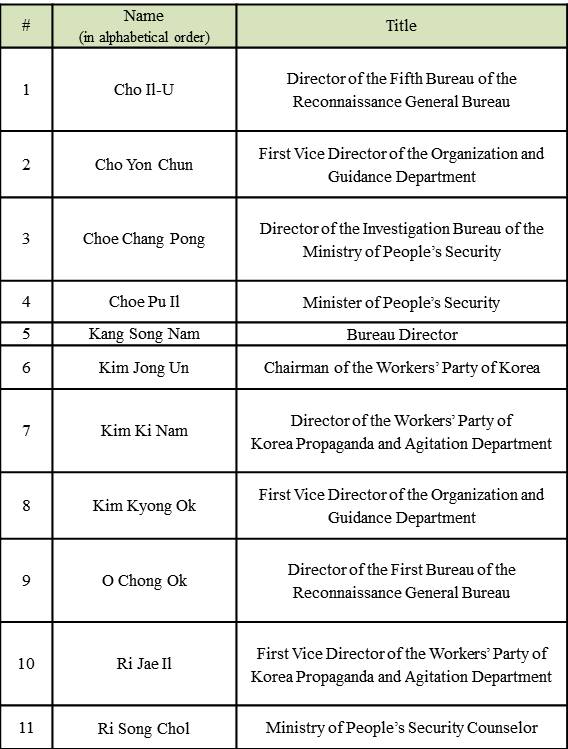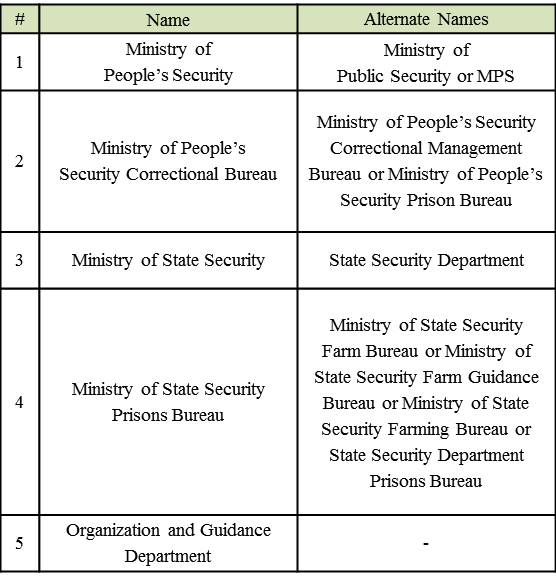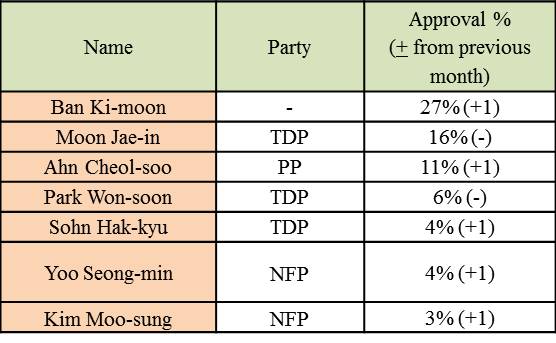THAAD
On July 8, Seoul and Washington announced their decision to deploy the Terminal High Altitude Area Defense (THAAD) in South Korea by the end of 2017.1 The decision came two weeks after North Korea test fired its intermediate range missile, Musudan. In response to the announcement, North Korea fired a submarine-launched ballistic missile (SLBM), which failed in the early stage of flight.2
The government designated Seongju, approximately 300 kilometers south of Seoul, as the location for THAAD. Local residents have strongly opposed the decision, citing health risks from exposure to electromagnetic waves.3 As anti-THAAD demonstrations continue, ex-opposition leader Ahn Cheol-soo stated that the government should “seriously consider putting the decision to a public vote.”4 In addressing such objections, President Park responded, “It is time to stop unnecessary dispute regarding the THAAD decision.” She also added, “Our government will continue to listen to and communicate with the residents of Seongju in the process of deploying THAAD.”5
A recent survey on THAAD reveals that 50% of the respondents are supportive, while 32% are opposed.6 The survey also suggests that partisan affiliation is a critical intervening factor, with 74% and 48% of supporters for the New Frontier Party (NFP) and People’s Party (PP), respectively, approving the THAAD decision.7 Supporters of the Together Democratic Party (TDP) and the Justice Party (JP) tended to oppose the decision, with 50% and 58% disapproving, respectively.8
Public Support for Government Decision on THAAD
Reasons for Approval
Reasons for Disapproval
UNCLOS
On July 12, the Permanent Court of Arbitration in the Hague ruled that China has no legal claim to the areas within the so-called “nine dash line” in the South China Sea. The Philippines filed the case against China in 2013 under the United Nations Convention on Laws of the Sea (UNCLOS).9
The South Korean government released its official response 16 hours after the decision, stating that it “takes note of the arbitral ruling” and “hopes that the disputes in the South China Sea will be resolved through peaceful and creative diplomatic efforts.”10 According to experts, this delicate response reflects, in part, Seoul’s balancing act between China and the United States, as well as its concern that Japan might initiate UNCLOS proceedings against South Korea over Dokdo.11
On the other hand, Japan immediately welcomed the UNCLOS decision, reaffirming that “China must follow the ruling.”12 Emphasizing that the South China Sea dispute is an issue of common interest for the international community, Prime Minister Abe stated, “The rule of law is a fundamental principle by which we must continue to abide.”13
US Sanction of North Korea
On July 10, the Obama administration introduced additional sanctions against key individuals and entities in North Korea, including Kim Jong-un, for alleged human rights violations.14 This marks the first time the North Korean leader has been personally targeted by US sanctions regime.
Kim Jong-un called the measure a “declaration of war” and severed the only existing communication channel between North Korea and the United States (i.e. informal channel of communication through the UN missions).15
Meanwhile, North Korean media did not mention the US sanctions against Kim Jong-un until July 13. Observers claim that the regime exercised significant care in announcing this issue internally, due to concerns that it may undermine the legitimacy and reputation of the Kim leadership.16
Individuals designated by E.O. 13722 and E.O. 1368717
Entities designated by E.O. 13722 and E.O. 1368718
Service Economy Development Strategy
On July 5, the government announced the Service Economy Development Strategies Plan, which aims to add 250,000 new jobs in the service sector in order to raise the share of employment contribution by services from 70% to 73% during 2015-2020.19 The plan calls for providing different types of tax breaks and financial support to manufacturing, infrastructure, and seven specific industries, namely medical services, tourism, contents, education, finance, software and logistics.20
To promote financial services, the Financial Services Commission (FSC) is also working on an auxiliary measure to nurture large investment banks. The plan is likely to be announced by the end of this month but it is already gaining traction in Seoul. The plan is expected to include incentives, such as expanding credit extension cap, for companies whose equity capital is larger than KRW 5 trillion.21 As of 2015, only Mirae Asset Daewoo meets the standard with equity value at KRW 5.837 trillion.22
The above measure is seen as an alternative to implementing the necessary reforms in the service sector, given the National Assembly’s repeated failure to pass the Service Industry Development Act.23 The administrative measure, however, falls short of structural reforms.24 Current plans also face significant legislative hurdles. For instance, one measure calls for expanding access to medical services in remote rural areas, which will require revising the Medical Act. This attempt will face stiff opposition in the National Assembly and the medical service sector.25
Economic Growth
The Bank of Korea (BOK) estimated South Korea’s economic growth rate at 2.4% for the remainder of 2016, bringing the annual average to 2.7%.26 The government’s stimulus, including the supplementary budget worth KRW 10 trillion and lowered benchmark interest rate, is expected to boost the economy by 0.2%.27 Increasing global uncertainties and restructuring of troubled sectors explain the Bank’s revised outlook.
Restructuring
Shipping companies are in the final phase of the conditional voluntary workout. Creditors demanded the two largest firms to meet three requirements before converting their investments to stocks: i) lower charter rates; ii) reduce debt and increase liquidity; and iii) join a shipping alliance.28 Hyundai Merchant Marine (HMM) met all three conditions29 and the creditors will move to implement the debt-equity swap and extend the maturity on loans. The largest creditor, KDB, will become the largest shareholder as a result of this arrangement.30
Hanjin Shipping, on the other hand, is struggling to lower charter rates and increase liquidity. Hanjin is thinking about requesting an extension on the current negotiation deadline, which is scheduled for August 4.31 If left to expire, Hanjin will be placed under court receivership.
Restructuring in the shipbuilding sector has drastically raised the unemployment rate in Gyeongsangnam-do, where all three of the largest shipbuilders are located. Although the province-wide unemployment is low by general standard at 3.9%, this is still 1% up from the same month last year and 0.3% higher than the national average.32
Presidential Candidates Approval Ratings
Contributing Staff(in alphabetical order): Han Minjeong, Eun A Jo, John J. Lee
Editorial Staff:Jo Eun A, J. James Kim
-
1.
“사드 한반도 배치… 루비콘강을 건너다,” 조선일보, 2016년 7월 9일.
-
2.
“北, 또 SLBM 무력시위…美 김정은제재·사드배치 반발인듯,” 연합뉴스, 2016년 7월 9일.
-
3.
“성주 사드반대 비대위→투쟁위로 전환…공동위원장 4명 선정,” 연합뉴스, 2016년 7월 16일.
-
4.
“안철수 “사드배치, 국민투표 검토를”… 칠곡군수는 삭발시위,” 조선일보, 2016년 7월 11일.
-
5.
“박 대통령 “사드 배치 관련 불필요한 논쟁 멈출 때,” 중앙일보, 2016년 7월 14일.
-
6.
“갤럽 “사드 한반도 배치, 찬성 50%, 반대 32%… 우리 지역 배치 수용 46%,” 중앙일보, 2016년 7월 15일.
-
7.
“갤럽 “사드 한반도 배치, 찬성 50% vs 반대 32%,” 연합뉴스, 2016년 7월 15일.
-
8.
Ibid.
-
9.
“상설중재재판소 “中, 남중국해의 구단선(九段線) 법적 근거 없다,” 조선일보, 2016년 7월 12일.
-
10.
“정부, ‘남중국해 판결’ 16시간만에 2문장 신중한 성명,” 한겨례, 2016년 7월 13일.
-
11.
Ibid.
-
12.
“’남중국해 격전장’ 된 ASEM…중재판결 찬반외교전 본격화,” 연합뉴스, 2016년 7월 16일.
-
13.
Ibid.
-
14.
“北, ‘美 김정은 인권제재’ 내부적으로 철저 통제,” 연합뉴스, 2016년 7월 13일.
-
15.
“北, 북-미 뉴욕채널 완전차단 美에 통보…김정은 제재반발(종합),” 연합뉴스, 2016년 7월 11일.
-
16.
“北, ‘美 김정은 인권제재’ 내부적으로 철저 통제,” 연합뉴스, 2016년 7월 13일.
-
17.
https://www.treasury.gov/resource-center/sanctions/OFAC-Enforcement/Pages/20160706.aspx
-
18.
https://www.treasury.gov/resource-center/sanctions/OFAC-Enforcement/Pages/20160706.aspx
-
19.
“서비스경제 발전전략 요약본,” 기획재정부, 2016년 7월 5일.
-
20.
Ibid.
-
21.
“‘한국판 골드만삭스’ 자기자본 기준, 5조냐 3조냐,” 한국일보, 2017년 7월 12일.
-
22.
Ibid.
-
23.
“서비스업도 제조업처럼 稅制 지원…정부 “일자리 25만개 창출,” 조선일보, 2016년 7월 6일.
-
24.
“[정부 ‘서비스경제 발전전략’] 모든 서비스 업종, 제조업 수준으로 세제정책자금 지원하다,” 경향비즈, 2016년 7월 5일.
-
25.
“장밋빛 경제대책, 실효성은 ‘글쎄요’,” 동아일보, 2016년 7월 14일.
-
26.
“2016 하반기 경제전망,” 한국은행, 2016년 7월 14일.
-
27.
“추경 10조 투입해도…한은, 올 성장률 2.8% -> 2.7% 하향,” 중앙일보, 2016년 7월 15일.
-
28.
“해운업계 구조조정, 이달 안에 ‘운명’ 판가름,” 경향신문, 2016년 7월 14일.
-
29.
“해운동맹 승선한 현대상선, 재활 준비 끝,” 중앙일보, 2016년 7월 15일.
-
30.
Ibid.
-
31.
“해운업계 구조조정, 이달 안에 ‘운명’ 판가름,” 경향신문, 2016년 7월 14일.
-
32.
“조선 구조조정 파장…경남 실업률, 전국 평균보다 높아져,” 중앙일보, 2016년 7월 14일.
-
33.
Date: July 12-14; sample size: 1,004; margin of error: +3.1 at the 95% confidence level.

 Facebook
Facebook Twitter
Twitter
